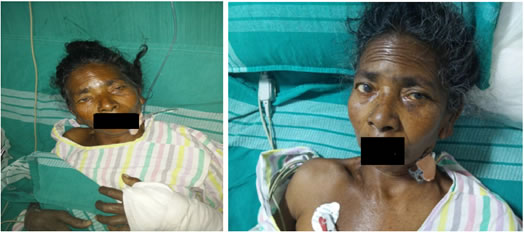|
Table of Content - Volume 4 Issue 2- November 2016
Neurotoxic manifestations of a Viperine bite - A case report
Shasthara P*, Anuj Nehete**, Anurag Lavekar#
{*,**Sr. Resident, Department of Neurology} {#Sr. Resident, Department of Gastroenterology and Hepatology} JSS Medical College and Hospital, Mysore, Karanataka, INDIA. Email: shasthara.p@gmail.com
Abstract Snakebite is one of the common life-threatening medical emergencies encountered in Indian population particularly in rural and farming areas. South Asia is the world’s most affected region by snakebite, due to its high population density, widespread agricultural activities, numerous venomous snake species and lack of appropriate information regarding primary treatment (first aid) in general population. Viperine venom contains haematotoxins and known to cause vasculotoxicity. Although venom may contain neurotoxins as well, clinical manifestation of neurotoxicity following Viperine bite is rare. We present a case of Viperine snake bite presenting with features of both neurotoxicity and haematotoxicity in a patient. Key Words: Snake bite, Viper, neurotoxicity, haematotoxicity.
INTRODUCTION India is estimated to have the highest snakebite mortality in the world. World Health Organization (WHO) estimates place the number of bites to be 83,000 per annum with 11,000 deaths2. There are about 236 species of snakes in India, most of which are nonpoisonous. Their bites, apart from causing panic reaction and local injury, do not harm the patient. However, there are 13 known species that are poisonous and of these four, namely common cobra (Naja naja), Russell’s viper (Dabiola russelii), saw-scaled viper (Echis carinatus) and common krait (Bungarus caeruleus) are highly venomous and believed to be responsible for most of the poisonous bites in India 2. Bleeding and clotting disorders are caused by Viperidae, like spontaneous systemic bleeding - from gums, epistaxis, intracranial hemorrhage, haemoptysis, haematemesis, rectal bleeding or melena, bleeding into the mucosae skin (petechiae, purpura, ecchymosis) and retina.Although venom may contain neurotoxins as well, clinical manifestation of neurotoxicity following Viperine bite is rare 3. Neurological complications like drowsiness, paraesthesiae, ptosis, external ophthalmoplegia, paralysis of facial muscles and difficulty in swallowing secretions, respiratory and generalized flaccid paralysis is noted in Elapidae bite. Both neurological and haematological manifestations although rare, can be seen in few species of Viper bite like Russell’s viper4.
CASE REPORT 45 year old female patient presented to emergency department with history of Russel’s Viperine snake bite to right thumb 5 hrs ago. At presentation patient had haematemesis 3 episodes along with ptosis of both eyelids. She had single breath count of 10 with hypotension and tachycardia. Her initial investigations revealed Whole blood clotting time of 40 min with deranged coagulation profile-INR 9. She had anemia (Hb 9gm/dl), leucocytosis(19,000), thrombocytopenia(70,000) with deranged RFT(Urea/Creatinine-88/1.9).Urine routine was normal with no myoglobinuria. D dimer was positive. ECG showed sinus tachycardia. She received total of 30 ml of ASV over 3 days along with Fresh frozen plasma and packed cells. She was treated with Neostigmine and atropine in view of ptosis. She was put on NIV and monitored in Intensive care unit. She received surgical care for right upper limb in the form of magnesium sulphate dressing and debridement with limb elevation and antibiotics in view of cellulitis. She made steady improvement, with recovery in coagulation parameters and ptosis. By day 4 WBCT, INR normalized. She was haemodynamically stable and was discharged on day 7.
Figure 1: Day 1: Ptosis Figure 2: Day 3: Improvement in ptosis
DISCUSSION Venoms of Viperidae contain serine proteases and other procoagulant enzymes that are thrombin-like or activate factor X, prothrombin and other clotting factors. These enzymes stimulate blood clotting with formation of fibrin in the blood stream. Paradoxically, this process results in incoagulable blood because most of the fibrin clot is broken down immediately by the body’s own plasmin fibrinolytic system and, sometimes within 30 minutes of the bite, the levels of clotting factors are depleted (“consumption coagulopathy”). Some species of Vipers (Mojavae/Russels viper) have Postsynaptic (α) neurotoxins such as α-bungarotoxin and cobrotoxin consist of 60-62 or 66-74 amino acids. They bind to acetylcholine receptors at the motor endplate. Presynaptic (β) neurotoxins such as β bungarotoxin, crotoxin, and taipoxin, contain 120-140 amino acids and a phospholipase A subunit. These release acetylcholine at the nerve endings at neuromuscular junctions and then damage the endings, preventing further release of transmitter producing neurotoxicity5. Rodney E et al6 in his study titled Paralysis, Rhabdomyolysis and Haemolysis Caused by Bites of Russell's Viper (Vipera russelli pulchella) in Sri Lanka-Failure of Indian (Haffkine) Antivenom showed that 23 patients with systemic envenomation after proven bites, Seventy-three per cent had swelling at the bite site, Neurotoxicity in 82 percent in the form of external ophthalmoplegia and 77 per cent had ptosis. Incoagulable blood was found in 59 per cent but only 36 per cent had spontaneous bleeding. Transient bilateral ptosis along with disseminated intravascular coagulation was observed in case report by Adrian Gillissen et al7. Viper bite is associated with coagulation abnormalities and renal failure with occasional reports of neurotoxicity, pituitary necrosis and increased vascular permeability. Considerable geographical variation in clinical presentation has been described following bite by some species of snakes including Cobra and Russell’s viper8-10.
CONCLUSION Viperine bite can produce diverse clinical presentations which includes neurotoxicity and vasculotoxicity. Viperine snake bite is predominantly haematotoxic. Neurotoxic manifestations although rare with Viperine bite, dual manifestations can be seen. Early identification of neurotoxicity is pivotal in preventing respiratory failure.
REFERENCES
Policy for Articles with Open Access
|
|
 Home
Home

